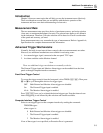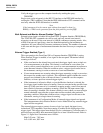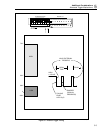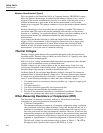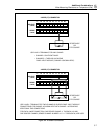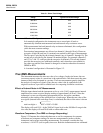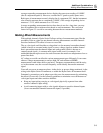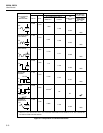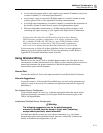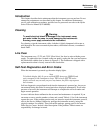
2620A, 2625A
Users Manual
5-8
Table 5-1. Ohms Test Voltage
Range Typical Full Scale Voltage
300.00 Ω 0.22
3.0000 kΩ 0.25
30.000 kΩ 0.29
300.00 kΩ 0.68
3.0000 MΩ 2.25
10.000 MΩ 2.72
• 4-Terminal Configuration
In 4-terminal configuration, the instrument uses a second pair of leads to
automatically eliminate measurement-lead and internal-relay resistance errors.
With measurement lead and internal relay resistances eliminated, this configuration
yields the most accurate readings.
Four-terminal measurements are allowed on channels 1 through 10 only. However,
two pairs of high (H) and low (L) terminals are needed for this type of measurement.
The first pair is provided by the selected channel (any of channels 1 through 10). The
second pair is provided by the channel 10 numbers higher. For example, channels 2
and 12 (or 7 and 17) could provide the two pairs of terminals. This second channel
provides the necessary two additional terminals, and is therefore not available for
any other use until the first channel is changed to a function other than 4-terminal
OHMS or RTD.
A 4-terminal configuration is illustrated in Figure 5-2.
True RMS Measurements
The instrument measures the true rms value of ac voltages. In physical terms, the rms
(root-mean-square) value of a waveform is the equivalent dc value that causes the same
amount of heat to be dissipated in a resistor. True rms measurement greatly simplifies
the analysis of complex ac signals. Since the rms value is the dc equivalent of the
original waveform, it provides a reliable basis for comparing dissimilar waveforms.
Effects of Internal Noise in AC Measurements
With the input shorted and the instrument set for ac volts (VAC) measurement, internal
amplifier noise causes a typical display reading of approximately 0.50 mV. Since the
instrument is a true rms responding measurement device, this noise contributes
minimally to the reading at the specified floor of each range. When the rms value of the
two signals (internal noise and range floor) is calculated, the effect of the noise is shown
as:
total rms digits = 0.50
2
+15.00
2
= 15.008
The display will read 15.01. At the 28.00 mV input level on the 300.00 mV range in the
slow rate, the display will read 28.00 with no observable error.
Waveform Comparison (True RMS vs Average Responding)
Figure 5-3 illustrates the relationship between ac and dc components for common
waveforms and compares readings for true-rms measurements (such as with the
instrument) and average-responding measurements. For example, consider the first
waveform, a 1.41421V (zero-to-peak) sine wave. Both the instrument and rms-calibrated






